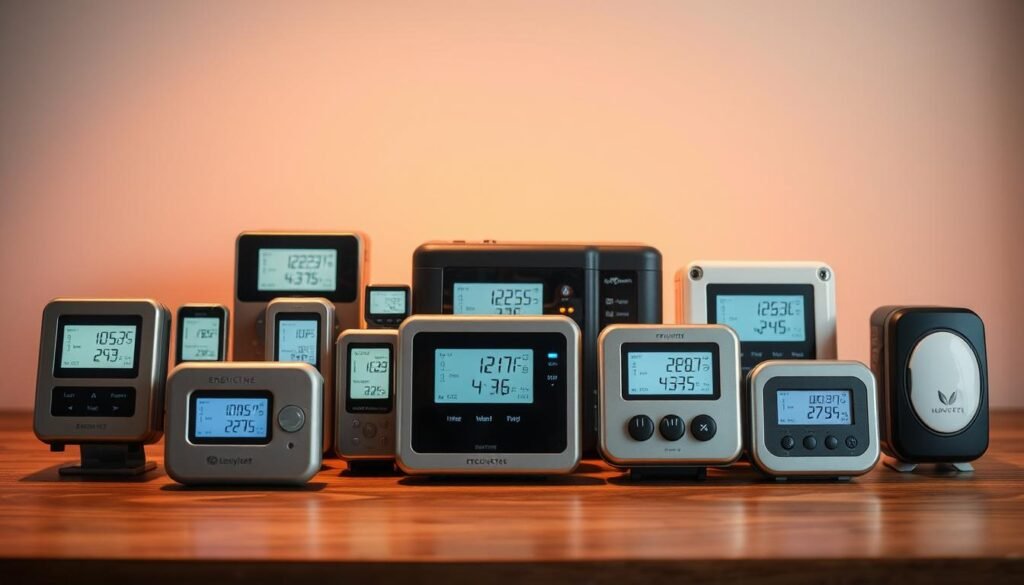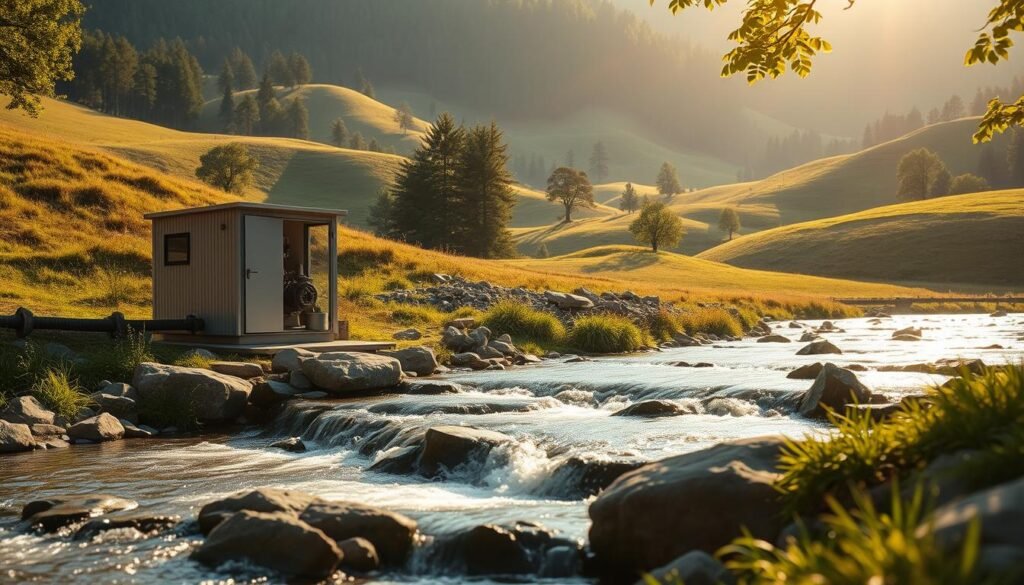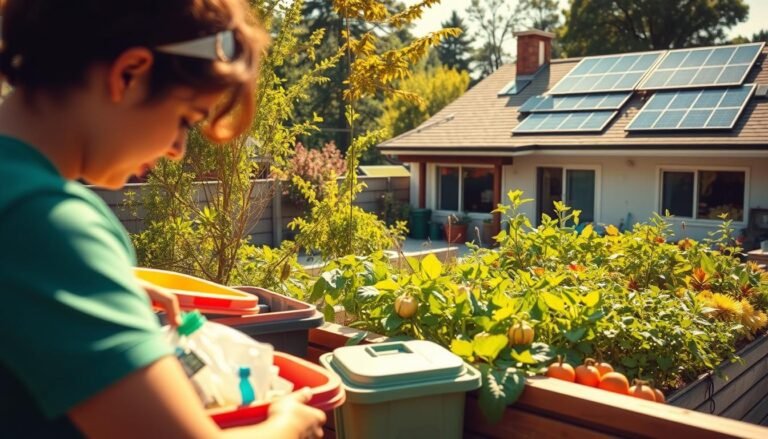Renewable Energy Options: Off-grid energy solutions are becoming increasingly vital for rural communities in Australia. With the rising costs of traditional energy sources, rural households are turning to sustainable alternatives to power their homes.
Sustainable electricity generated from sources like solar and wind power can significantly improve the quality of life for those living in remote areas. By adopting renewable energy solutions, rural households can reduce their reliance on the grid and enjoy a more reliable and environmentally friendly source of power.
Key Takeaways
- Off-grid energy solutions are crucial for rural households.
- Renewable energy can improve the quality of life in remote areas.
- Sustainable electricity reduces reliance on traditional energy sources.
- Rural communities benefit from environmentally friendly energy options.
- Adopting renewable energy solutions enhances energy reliability.
The Rural Energy Challenge in Australia
The energy landscape for rural Australia is characterized by unique hurdles, including limited grid access. Rural households face distinct energy challenges that are not typically encountered in urban areas, primarily due to their remote locations and the high costs associated with connecting to the main grid.
Unique Energy Needs of Rural Properties
Rural properties often have different energy requirements compared to their urban counterparts. These needs are influenced by factors such as larger land sizes, the need for water pumping, and the use of machinery for farming or other rural activities. Solar power emerges as a viable solution for many of these energy needs, offering a clean and renewable source of energy.
Grid Connection Limitations and Costs
Connecting to the grid can be prohibitively expensive for rural households, with costs often running into tens of thousands of dollars. The distance from the existing grid infrastructure and the terrain are significant factors that contribute to these high costs. A detailed breakdown of these costs is as follows:
| Cost Component | Typical Cost Range |
|---|---|
| Line extension costs | $10,000 – $50,000 |
| Transformer installation | $5,000 – $20,000 |
| Metering and connection fees | $1,000 – $5,000 |
The Case for Self-Sufficient Power
Given the challenges and costs associated with grid connection, self-sufficient power solutions such as solar and wind energy become increasingly attractive. These renewable energy sources can provide reliable and cost-effective power to rural households, reducing dependence on the grid and enhancing energy security.
By adopting self-sufficient power solutions, rural households can not only reduce their energy costs but also contribute to a more sustainable energy future. As technology continues to evolve, the efficiency and affordability of these solutions are expected to improve, making them an even more compelling option for rural Australians.
Understanding Off-Grid Living in the Australian Context
For many Australians, off-grid living represents a lifestyle choice that combines self-sufficiency with environmental responsibility. This approach to living involves generating and managing one’s own energy needs, reducing reliance on the national grid.
What Does “Off-Grid” Really Mean?
Off-grid living means being self-sufficient in terms of energy production. It involves using renewable energy sources such as solar, wind, or hydro power to meet your household’s energy needs.
Benefits of Energy Independence
Energy independence offers numerous benefits, including reduced energy costs and increased resilience to grid outages. Off-grid systems can provide power even in remote areas where traditional grid connection is not feasible or is too expensive.
Australian Climate Zones and Their Impact on Energy Choices
Australia’s diverse climate zones significantly influence the choice of off-grid energy systems. For instance, solar power is more effective in the northern regions, while wind energy might be more suitable in southern areas.
| Climate Zone | Primary Energy Source | Secondary Energy Source |
|---|---|---|
| Tropical North | Solar | Wind |
| Southern Regions | Wind | Solar |
| Desert Areas | Solar | Diesel Generator |
Understanding these climate-specific energy needs is crucial for designing an effective off-grid energy system.
Assessing Your Household Energy Requirements
Understanding your energy needs is crucial for selecting the right off-grid energy solution for your rural property. Assessing your household energy requirements involves several key steps, including calculating your daily energy consumption and considering seasonal variations in energy needs.
Calculating Daily Energy Consumption
To calculate your daily energy consumption, start by making a list of all the appliances and devices you use regularly. Note down their power ratings and the number of hours you use them each day. You can then calculate the total daily energy consumption in watt-hours (Wh) or kilowatt-hours (kWh).
| Appliance | Power Rating (W) | Daily Usage (h) | Daily Energy Consumption (Wh) |
|---|---|---|---|
| LED Light | 9 | 8 | 72 |
| Refrigerator | 100 | 24 | 2400 |
| Laptop | 50 | 4 | 200 |
Seasonal Variations in Energy Needs
Energy needs can vary significantly with the seasons. For example, you may need more energy for heating during winter or for cooling during summer. It’s essential to consider these seasonal variations when assessing your energy requirements to ensure your off-grid energy system can meet your needs throughout the year.
Tools for Energy Auditing
There are several tools available for energy auditing, including energy monitoring devices and professional energy assessments.
Energy Monitoring Devices
Energy monitoring devices can help you track your energy usage in real-time, providing valuable insights into your energy consumption patterns.

A professional energy assessment can provide a comprehensive evaluation of your energy needs and identify opportunities for energy efficiency improvements.
By using these tools and techniques, you can gain a better understanding of your household energy requirements and make informed decisions about your off-grid energy solution.
Solar Power Systems for Rural Australian Properties
For rural Australian households, solar power systems offer a reliable and sustainable energy solution. With abundant sunlight throughout the year, rural properties are ideal candidates for harnessing solar energy. Solar energy solutions can significantly reduce reliance on traditional energy sources, providing both economic and environmental benefits.
Types of Solar PV Systems for Off-Grid Applications
There are several types of solar PV systems suitable for off-grid applications in rural Australia. These include:
- Stand-alone PV systems: These systems are designed to operate independently, providing power directly to the household or property.
- Hybrid PV systems: Combining solar PV with other energy sources like wind or diesel generators, these systems offer a reliable and flexible energy solution.
- PV-diesel hybrid systems: These systems use solar PV as the primary energy source and diesel generators as a backup, ensuring continuous power supply.
Sizing Your Solar Array for Australian Conditions
Sizing a solar array correctly is crucial for meeting the energy needs of rural households. Factors to consider include:
- Daily energy consumption
- Seasonal variations in sunlight
- Panel efficiency and quality
- System losses and battery efficiency
It’s essential to conduct a thorough energy audit to determine the appropriate size of the solar array for your specific needs.
Mounting Options for Rural Settings
The mounting system for solar panels is critical for maximizing energy production. Options include:
- Fixed tilt mounts: Suitable for most rural properties, these mounts are set at an optimal angle to capture sunlight.
- Tracking mounts: These mounts follow the sun’s movement, potentially increasing energy production by up to 25%.
Solar Hot Water Systems as Complementary Technology
In addition to solar PV systems, solar hot water systems can provide a complementary energy solution. By harnessing solar energy to heat water, these systems can reduce the energy load on your solar PV system, enhancing overall efficiency.
By understanding the different aspects of solar power systems, rural Australian households can make informed decisions about their energy needs, moving towards a more sustainable and self-sufficient energy future.
Wind Energy Solutions for Country Homes
Wind energy is becoming increasingly viable for country homes, providing a clean and renewable source of electricity. As rural households seek to reduce their reliance on traditional power sources, wind energy solutions offer a promising alternative.
Small-Scale Wind Turbines Suitable for Australian Conditions
Small-scale wind turbines are designed to operate efficiently in various wind conditions, making them suitable for rural Australian properties. These turbines are typically smaller than commercial wind turbines and are designed for lower wind speeds. When selecting a small-scale wind turbine, consider factors such as:
- Rotor diameter and height
- Power output and voltage
- Noise levels and durability
- Certification and compliance with Australian standards
Wind Resource Assessment Techniques
Before installing a wind turbine, it’s crucial to assess the wind resource on your property. Techniques for wind resource assessment include:
- Installing anemometers to measure wind speed and direction
- Using historical wind data from nearby weather stations
- Conducting on-site wind measurements over a period of time
Accurate wind resource assessment is essential for determining the feasibility of a wind energy project.
Zoning and Council Regulations Across Australian States
Zoning and council regulations regarding wind turbines vary across Australian states. It’s essential to consult with local authorities to understand the specific requirements, such as:
- Setback distances from property boundaries and dwellings
- Height restrictions and noise limits
- Environmental impact assessments
Noise Considerations for Rural Properties
While wind turbines are generally quiet, they can generate some noise. To minimize disturbance, consider the placement of turbines in relation to neighboring properties and dwellings. Proper installation and maintenance can also help reduce noise levels.
By understanding the factors involved in wind energy solutions, rural households can make informed decisions about harnessing wind power for their energy needs.
Micro-Hydro Power for Properties with Water Resources
For rural properties with accessible water resources, micro-hydro power presents a viable and sustainable electricity solution. This form of renewable energy harnesses the power of moving water to generate electricity, providing a reliable and consistent source of power for off-grid living.
Stream Assessment and Requirements
Before installing a micro-hydro system, a thorough stream assessment is necessary. This involves evaluating the water flow, head (vertical distance water falls), and other hydrological factors to determine the potential energy output. Key factors include the stream’s flow rate, measured in liters per second, and the head, which affects the system’s pressure and efficiency.
Types of Micro-Hydro Systems
There are several types of micro-hydro systems, including run-of-river, pondage, and micro-hydro with storage. Run-of-river systems are the most common, utilizing the natural flow of the stream without significant water storage. The choice of system depends on the site’s specific characteristics and energy requirements.

Environmental Considerations and Water Rights
Micro-hydro power systems must be designed and operated with careful consideration of environmental impacts. This includes assessing the effects on aquatic life, water quality, and surrounding ecosystems. Additionally, property owners must comply with local water rights regulations and obtain necessary permits.
Seasonal Reliability in Australia’s Variable Climate
Australia’s climate variability poses challenges for micro-hydro power reliability, particularly during dry seasons. A well-designed system should account for seasonal fluctuations in water flow. A comprehensive stream assessment and appropriate system sizing are crucial for ensuring a reliable energy supply throughout the year.
| System Type | Reliability | Environmental Impact |
|---|---|---|
| Run-of-River | Variable | Low to Moderate |
| Pondage | Moderate | Moderate |
| Micro-Hydro with Storage | High | Moderate to High |
Renewable Energy Options for Rural Households: Comparing Technologies
Rural Australian households have various renewable energy options to consider, but choosing the right one requires careful evaluation. The decision involves assessing different technologies based on their cost, reliability, environmental impact, and maintenance needs.
Cost-Benefit Analysis of Different Systems
A thorough cost-benefit analysis is crucial when comparing renewable energy technologies. Solar power systems, for instance, have become increasingly cost-competitive, with the cost of solar panels decreasing significantly over the past decade. Wind energy, on the other hand, can be more viable for properties with suitable wind resources. Micro-hydro systems, while highly reliable, often require significant upfront investment due to the need for specific site conditions.
- Solar PV: High initial cost, low maintenance
- Wind Turbines: Moderate initial cost, moderate maintenance
- Micro-Hydro: High initial cost, low maintenance
Reliability Factors in Extreme Australian Conditions
Reliability is a key factor, especially in Australia’s extreme climate conditions. Solar power is generally reliable, but its output can be affected by seasonal variations and weather events. Wind turbines can also be reliable, but their performance depends on consistent wind speeds. Micro-hydro systems are typically the most reliable, as they can provide a consistent power output if the water resource is stable.
Environmental Impact Considerations
The environmental impact of each technology varies. Solar PV systems have a relatively low environmental footprint, while wind turbines can have some impact on local wildlife. Micro-hydro systems can affect aquatic ecosystems, so careful planning is required to mitigate these impacts.
Maintenance Requirements and Accessibility
Maintenance needs also differ among the technologies. Solar PV systems require occasional cleaning and inspection, while wind turbines need regular maintenance of moving parts. Micro-hydro systems require less frequent maintenance but can be more challenging to access for repairs.
In conclusion, comparing different renewable energy options for rural households involves a detailed assessment of various factors. By understanding the cost-benefit analysis, reliability, environmental impact, and maintenance requirements of each technology, rural households can make informed decisions about their energy future.
Energy Storage Solutions for Off-Grid Living
Effective energy storage is crucial for off-grid living, enabling households to store excess energy generated from renewable sources. This capability ensures a stable and reliable power supply, even when the primary energy source is not available.
Battery Technologies for Australian Climate Conditions
Australian climate conditions vary significantly across the country, from the tropical north to the temperate south. Battery technologies such as lithium-ion and lead-acid batteries are popular choices for off-grid energy storage due to their reliability and efficiency. Lithium-ion batteries, for instance, offer high energy density and a long cycle life, making them suitable for homes with high energy demands.
Sizing Your Battery Bank for Self-Sufficiency
Sizing a battery bank correctly is critical for achieving energy self-sufficiency. The size of the battery bank depends on several factors, including daily energy consumption, the desired backup period, and the type of battery technology used. A thorough assessment of these factors ensures that the battery bank can meet the household’s energy needs during periods of low renewable energy generation.
Battery Management and Maximizing Lifespan
Battery management is essential for maximizing the lifespan of the battery bank. This involves monitoring the state of charge, controlling the depth of discharge, and maintaining the batteries within optimal temperature ranges. Proper battery management can significantly extend the life of the batteries, reducing the overall cost of the energy storage system.
Temperature Management in Extreme Climates
Australia’s climate can be quite extreme, with temperatures soaring in the outback and dropping significantly in the southern regions. Temperature management is crucial for maintaining battery performance and longevity. Batteries should be housed in a temperature-controlled environment or protected from extreme temperatures to ensure optimal operation.
In conclusion, energy storage solutions are a vital component of off-grid living, providing households with the ability to store excess energy for later use. By selecting the right battery technology, sizing the battery bank appropriately, and implementing effective battery management and temperature control measures, rural households can enjoy a reliable and efficient energy supply.
Hybrid Systems: Creating Resilient Power Solutions
Hybrid energy systems, which combine different renewable energy technologies, are becoming increasingly popular among rural Australians. These systems offer a robust solution to energy needs by integrating multiple power generation sources, thereby enhancing reliability and efficiency.
Solar-Wind Hybrid Systems for Year-Round Power
Solar-wind hybrid systems are particularly effective for year-round power generation in rural areas. By combining solar photovoltaic (PV) panels with wind turbines, these systems can provide a consistent energy supply even during periods of low sunlight or calm winds. This hybrid approach maximizes energy production and reduces reliance on a single energy source.
Integrating Backup Generators Effectively
Backup generators play a crucial role in hybrid systems by providing additional power during periods of high demand or when renewable energy sources are insufficient. To integrate backup generators effectively, it’s essential to size them appropriately for your energy needs and ensure they are compatible with your overall energy system.
System Integration and Control Technologies
Effective system integration and control technologies are vital for the smooth operation of hybrid energy systems. Advanced control systems can monitor energy production, consumption, and storage in real-time, optimizing energy distribution and reducing waste. These technologies enable homeowners to manage their energy usage efficiently and make informed decisions about their energy needs.
Adapting Your System to Seasonal Changes
Rural Australian households experience significant seasonal variations in energy needs due to changing weather conditions. To adapt your hybrid system to these changes, it’s crucial to assess your energy requirements during different seasons and adjust your system accordingly. This may involve adjusting the energy storage capacity or modifying the operation of backup generators.
By implementing a hybrid energy system, rural households can achieve a resilient and sustainable power solution, reducing their reliance on the grid and lowering energy costs.
Financial Considerations and Return on Investment
Understanding the financial considerations of renewable energy is essential for rural households. The initial investment in renewable energy systems can be substantial, but it’s crucial to consider the long-term benefits and savings.
Initial Investment vs. Long-Term Savings
The initial cost of renewable energy systems, such as solar or wind power, can be significant. However, these systems offer substantial long-term savings on energy bills. For instance, a well-designed solar PV system can save households thousands of dollars over its lifespan.
Australian Government Rebates and Incentives
The Australian government offers various rebates and incentives to encourage the adoption of renewable energy. These can significantly offset the initial investment costs. For example, the Small-scale Renewable Energy Scheme (SRES) provides financial incentives for installing solar and other renewable energy systems.
Rural-Specific Grants and Programs
There are also rural-specific grants and programs designed to support the transition to renewable energy. These grants can help cover the costs of system installation, making renewable energy more accessible to rural households.
Financing Options for Renewable Energy Systems
Various financing options are available to help rural households invest in renewable energy systems. These include loans and financing plans specifically designed for renewable energy projects.
| Financing Option | Interest Rate | Repayment Term |
|---|---|---|
| Renewable Energy Loan | 4.5% | 10 years |
| Green Energy Finance | 5.0% | 12 years |
| Solar Financing Plan | 3.9% | 8 years |
By understanding the financial considerations and available incentives, rural households can make informed decisions about adopting renewable energy systems.
Installation Considerations for Remote Properties
The installation process for renewable energy systems in rural areas involves unique challenges that must be addressed. Remote properties often face logistical hurdles that can complicate the installation of off-grid energy systems.
Finding Qualified Installers in Regional Australia
One of the primary concerns is finding qualified installers who have experience with off-grid energy systems. It’s essential to work with professionals who understand the specific requirements of rural Australian properties. You can start by checking for certifications from reputable organizations and asking for references from previous clients in similar settings.
DIY vs. Professional Installation: What’s Realistic
While DIY installation might seem like a cost-effective option, it’s crucial to assess whether it’s realistic for your specific situation. Professional installation ensures that the system is set up correctly and safely, which is particularly important for remote properties where maintenance could be challenging.
Site Preparation Requirements
Before installation, the site must be prepared to ensure optimal performance and safety. This includes assessing the land for any potential hazards, clearing vegetation if necessary, and ensuring that the installation site is accessible. Proper site preparation is vital for the longevity and efficiency of the energy system.
Logistics of Equipment Transport to Remote Locations
Transporting equipment to remote locations can be a significant challenge. It’s essential to plan ahead, considering the weight and size of the equipment, as well as the condition of the roads leading to the property. For more information on programs that might assist with the costs or logistics of installing renewable energy systems in remote areas, you can visit resources like the Clean Energy for Rural and Remote Communities, although this is a Canadian resource, it provides valuable insights into the challenges and potential solutions for remote energy installations.
By carefully considering these factors, rural households can ensure a successful installation of their off-grid energy system, paving the way for a sustainable and reliable energy supply.
Maintaining Your Off-Grid Energy System
To ensure the longevity and efficiency of your off-grid energy system, regular maintenance is essential. This involves a combination of routine checks, seasonal maintenance schedules, and troubleshooting common issues that may arise.
Seasonal Maintenance Schedule
Creating a seasonal maintenance schedule is vital for the upkeep of your off-grid energy system. This schedule should include tasks such as cleaning solar panels, inspecting wind turbine blades, and checking battery health. For instance, during the wet season, it’s crucial to ensure that your system’s electrical components are protected from moisture.
Troubleshooting Common Issues in Rural Settings
Troubleshooting is an essential skill for off-grid energy system owners. Common issues include voltage drops, faulty inverters, and battery malfunction. Understanding how to diagnose and rectify these problems can save time and reduce downtime. For example, a voltage drop can often be traced back to improper wiring or corroded connections.
Creating Redundancy in Critical Systems
Creating redundancy in critical systems ensures that your off-grid energy system remains operational even if one component fails. This can be achieved by installing duplicate critical components or having backup systems in place. For wind energy systems, having a secondary power source, like solar panels, can provide redundancy during periods of low wind.
Building Your Maintenance Skill Set
Building your maintenance skill set is crucial for the long-term success of your off-grid energy system. This involves staying informed about the latest technologies, participating in workshops, and engaging with online forums. By enhancing your knowledge, you can perform maintenance tasks more effectively and troubleshoot issues with confidence.
By following these guidelines, you can ensure that your off-grid energy system remains reliable, efficient, and capable of meeting your energy needs.
Conclusion: Powering Your Rural Australian Lifestyle Sustainably
Rural households in Australia can significantly benefit from adopting renewable energy options to power their off-grid living. By choosing the right renewable energy solution, households can reduce their reliance on the grid and lower their energy costs, contributing to a sustainable lifestyle.
Renewable energy options such as solar, wind, and micro-hydro power provide a reliable source of sustainable electricity for rural areas. Assessing your household’s energy requirements and selecting the most suitable technology is crucial for achieving energy independence.
With the various renewable energy options available, rural households can create a resilient power solution that meets their needs. By investing in renewable energy, households can enjoy a sustainable and self-sufficient lifestyle while minimizing their environmental impact.
Embracing renewable energy options is a step towards a sustainable future for rural Australia, enabling households to thrive in harmony with the environment.





